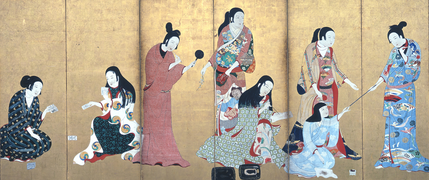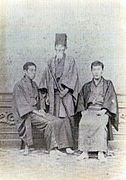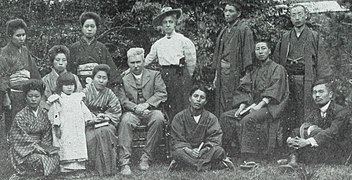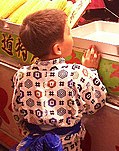Kimono


| Kimono | |||||
|---|---|---|---|---|---|
'Kimono' inkanji | |||||
| Japanese name | |||||
| Kanji | Trứ vật | ||||
| |||||
Thekimono(きもの/Trứ vật,lit. 'thing to wear')[a]is a traditional Japanese garment and the national dress ofJapan.The kimono is a wrapped-front garment with square sleeves and a rectangular body, and is wornleft side wrapped over right,unless the wearer is deceased.[2]The kimono is traditionally worn with a broad sash, called anobi,and is commonly worn with accessories such aszōrisandals andtabisocks.
Kimono have a set method of construction and are typically made from a long, narrow bolt of cloth known as atanmono,though Western-style fabric bolts are also sometimes used.[3]There are different types of kimono for men, women, and children, varying based on the occasion,the season,the wearer's age, and – less commonly in the modern day – the wearer's marital status. Despite the kimono's reputation as a formal and difficult-to-wear garment, there are types of kimono suitable for both formal and informal occasions. The way a person wears their kimono is known askitsuke(Trứ phó け,lit. 'dressing').
The history of the kimono can be tracked back to the Heian period (794–1185), when Japan's nobility embraced a distinctive style of clothing. Formerly the most common Japanese garment, the kimono has fallen out of favor and is rarely worn as everyday dress now. They are most often seen at summer festivals, where people frequently wear theyukata,the most informal type of kimono. More formal types are worn to funerals, weddings, graduations, and other formal events.Geishaandmaikoare required to wear a kimono as part of their profession, andrikishi(sumowrestlers) must wear kimonos at all times in public.[4]Despite the small number of people who wear it regularly and its reputation as a complicated garment, the kimono has experienced a number of revivals in previous decades, and is still worn today as fashionable clothing in Japan.
History
[edit]This sectionneeds additional citations forverification.(August 2020) |
-
Women's dress underGoguryeoinfluence, with overlapping collar andmoskirt.[5](Takamatsuzuka Tomb,7th century)
-
Asuka(lateYamato Period) dress, 7th century
-
Nara-perioddress, late 8th century, 2005 reconstruction
Yamato period to Nara period (300–794)
[edit]The first instances of kimono-like garments in Japan weretraditional Chinese clothingintroduced to Japan via Chinese envoys in theKofun period(300–538 CE; the first part of the Yamato period), through immigration between the two countries andenvoys to the Tang dynasty courtleading to Chinese styles of dress, appearance, and culture becoming extremely popular in Japanese court society.[1]The Imperial Japanese court quickly adopted Chinese styles of dress and clothing,[6]with evidence of the oldest samples ofshiboritie-dyed fabric stored at theShōsōin Templebeing of Chinese origin, due to the limitations of Japan's ability to produce the fabrics at the time.[7]As early as the 4th century CE, images of priestess-queens and tribal chiefs in Japan depicted figures wearing clothing similar that ofHan dynastyChina.[8]
In 718 CE, theYoroclothing code was instituted, which stipulated that all robes had to be overlapped at the front with a left-to-right closure, following typical Chinese fashions.[9]: 133–136 This convention of wear is still followed today, with a right-to-left closure worn only by the deceased.[9]
Clothing used by the upper classes was significantly simpler to don and wear than dress from the following Heian period.[10]Sleeves, while narrow, were long enough to cover the fingers, since status was associated with covering more of the body.[11][10]
Heian period to Azuchi–Momoyama period (794–1600)
[edit]During theHeian period(794–1193 CE), Japan stopped sending envoys to the Chinese dynastic courts. This prevented Chinese-imported goods—including clothing—from entering theImperial Palace.This also prevented dissemination to the upper classes, who were the main arbiters of traditional Japanese culture at the time, and the only people allowed to wear such clothing.[12]The ensuing cultural vacuum facilitated the development of a Japanese culture independent from Chinese fashions. Elements previously lifted from the Tang Dynastic courts developed independently into what is known literally as "national culture" or "kokufūculture "(Quốc phong văn hóa,kokufū-bunka).The term is used to refer to Heian-period Japanese culture, particularly that of the upper classes.[13]
Women's clothing in the imperial palace became increasingly stylised in the formaljūnihitoe,with some elements being abandoned by both male and female courtiers, such as the round-necked and tube-sleevedchun jujacket worn by both genders in the early 7th century. Others, such as the wrapped front robes also worn by men and women, were kept. Some elements, such as themoskirt worn by women, continued to in a reduced capacity, worn only to formal occasions;[1]themо̄(Thường)grew too narrow to wrap all the way around and became a trapezoidal pleatedtrain.[14]Hakama(trousers) became longer than the legs and also trailed behind the wearer.[15]
During the later Heian period, various clothing edicts reduced the number of layers a woman could wear, leading to thekosode(lit. 'small sleeve') garment—previously considered underwear—becoming outerwear by the time of theMuromachi period(1336–1573 CE). Originally worn withhakama,thekosodebegan to be held closed with a small belt known as anobiinstead.[1]Thekosoderesembled a modern kimono, though at this time the sleeves were sewn shut at the back and were smaller in width (shoulder seam to cuff) than the body of the garment. During theSengoku period(1467–1615) and theAzuchi–Momoyama period(1568–1600), the decoration of thekosodedeveloped further, with bolder designs and flashy colours becoming popular. By this time, separate lower-body garments, such as themōandhakama,were almost never worn,[15]allowing full-length patterns to be seen.
-
In the late Heian period, thejūnihitoeconsisted of many layers (hitoe) worn over a plainkosodeandhakama.[16](The Tale of Genji,12th century)
-
The courtiers in the foreground are wearing theirhitoeoff-the-shoulder, showing thekosodebeneath.
-
Thekosodeworn as outerwear. Note wider cut of the body, unisex narrowobiand shorter sleeves. Matsuurabyōbu,c. 1650,Azuchi-Momoyama period.
Edo period (1603–1867)
[edit]
During theEdo period(1603–1867 CE), both Japan's culture and economy developed significantly. A particular factor in the development of the Edo period was the earlyGenrokuperiod (1688–1704 CE), wherein "Genroku culture"– luxurious displays of wealth and increased patronage of the arts – led to the further development of many art forms, including those of clothing. Genroku culture was led by the growing and increasingly-powerfulmerchant classes(chōnin), whose clothing was representative of their increasing economic power and rivaled the aristocracy and samurai classes, shown by their brightly-coloured kimono that utilised expensive production techniques, such as hand-painted dyework.[17]Rinzu,adamaskfabric, also became the preferred material for kimono at this time, replacing the previously-popularnerinukiplain-weave silk, which had been used to createtsujigahana.[18]
In response to the increasing material wealth of the merchant classes, theTokugawa shogunateissued a number of sumptuary laws on kimono for the lower classes, prohibiting the use of purple or red fabric, gold embroidery, and the use of intricately dyedshiboripatterns.[19]As a result, a school of aesthetic thought known asIkideveloped. They valued and prioritised the display of wealth through an almost mundane appearance, and the concept of kimono design and wear continues to this day as a major influence.
From this point onwards, the basic shape of both men's and women's kimono remained largely unchanged.[1]The sleeves of thekosodebegan to grow in length, especially amongst unmarried women, and theobibecame much longer and wider, with various styles of knots coming into fashion, alongside stiffer weaves of material to support them.[1]
In the Edo period, the kimono market was divided into craftspeople, who made thetanmonoand accessories,tonya,or wholesalers, and retailers.[20]: 129
Modern period
[edit]Meiji period (1868–1912)
[edit]-
Part of the Ootuki family in kimono, 1874
-
Assorted types of kimono, Western dress, a court lady inkeiko,and a schoolgirl in a high-collared shirt, kimono andhakama.All wear both purple and red. 1890.
-
Family ofHoriai Setsuko,May 1912, some in European dress, some in kimono, some wearinghakama.Women'shakamaspread from the court as part ofJapanese reform dress.
In 1869, the social class system was abolished, and with them, class-specific sumptuary laws.[20]: 113 Kimono with formerly-restricted elements, like red and purple colours, became popular,[20]: 147 particularly with the advent of synthetic dyestuffs such asmauvine.
Following the opening of Japan's borders in the early Meiji period to Western trade, a number of materials and techniques – such as wool and the use of synthetic dyestuffs – became popular, with casual wool kimono being relatively common in pre-1960s Japan; the use of safflower dye (beni) for silk linings fabrics (known asmomi;literally, "red silk" ) was also common in pre-1960s Japan, making kimono from this era easily identifiable.
During theMeiji period,the opening of Japan to Western trade after the enclosure of the Edo period led to a drive towards Western dress as a sign of "modernity". After an edict byEmperor Meiji,[citation needed]policemen, railroad workers and teachers moved to wearing Western clothing within their job roles, with the adoption of Western clothing by men in Japan happening at a much greater pace than by women. Initiatives such as the Tokyo Women's & Children's Wear Manufacturers' Association(Đông kinh phụ nhân tử cung phục tổ hợp)promoted Western dress as everyday clothing.
Taishō period (1912–1926)
[edit]Western clothing quickly became standard issue asarmy uniformfor men[21]and school uniform for boys, and between 1920 and 1930, thefukusailor outfitreplaced the kimono and undividedhakamaas school uniform for girls.[1]: 140 However, kimono still remained popular as an item of everyday fashion; following theGreat Kantō Earthquakeof 1923, cheap, informal and ready-to-wearmeisenkimono, woven from raw and waste silk threads unsuitable for other uses, became highly popular, following the loss of many people's possessions.[22]By 1930, ready-to-wearmeisenkimono had become highly popular for their bright,seasonally changing designs,many of which took inspiration from theArt Decomovement.Meisenkimono were usually dyed using theikat(kasuri) technique of dyeing, where either warp or both warp and weft threads (known asheiyō-gasuri)[22]: 85 were dyed using a stencil pattern before weaving.
It was during the Taishō period that the modern formalisation of kimono and kimono types began to emerge. The Meiji period had seen the slow introduction of kimono types that mediated between the informal and the most formal, a trend that continued throughout the Taishō period, as social occasions and opportunities for leisure increased under the abolition of class distinctions. As Western clothing increased in popularity for men as everyday clothing, the kimono industry further established its own traditions of formal and informal dress for women; this saw the invention of thehōmongi,divisions oftomesode(short-sleeved) kimono for women, andmontsuki hakama.[20]: 133-134 The bridal kimonotrousseau(oyomeiri dōgu), an uncommon practice of the upper classes in the Edo period, also became common throughout the middle classes;[20]: 67, 76 traditions of kimono bridalwear for marriage ceremonies were also codified in this time, which resembled the bridalwear of samurai-class women.[20]: 82, 93, 146 Standards ofkitsukeat this time began to slowly graduate to a more formalised, neatened appearance, with a flat, uniformohashoriand a smooth, uncreasedobi,which also resembled the "proper"kitsukeof upper-class women. However,kitsukestandards were still relatively informal, and would not become formalised until after World War II.
Shōwa period (1926–1989)
[edit]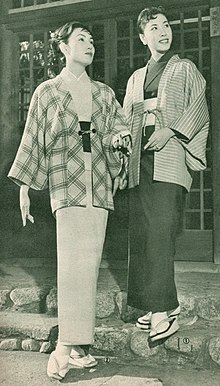
While kimono were no longer common wear for men, they remained everyday wear for Japanese women untilWorld War II(1940–1945).[20]: 17 Though the Taishō period had seen a number of invented traditions, standards ofkitsuke(wearing kimono) were still not as formalised in this time, with creases, unevenohashoriand crookedobistill deemed acceptable.[20]: 44-45
During the war, kimono factories shut down, and the government encouraged people to wearmonpe(also romanised asmompe) – trousers constructed from old kimono – instead.[20]: 131 Fibres such as rayon became widespread during WWII, being inexpensive to produce and cheap to buy, and typically featured printed designs.[citation needed]Cloth rationing persisted until 1951, so most kimono were made at home from repurposed fabrics.[20]: 131
In the second half of the 20th century, the Japanese economy boomed,[20]: 36 and silk became cheaper,[citation needed]making it possible for the average family to afford silk kimono.[20]: 76 The kimono retail industry had developed an elaborate codification of rules for kimono-wearing, with types of kimono, levels of formality, and rules on seasonality, which intensified after the war; there had previously been rules about kimono-wearing, but these were not rigidly codified and varied by region and class.[20]: 36 Formalisation sought perfection, with no creases or unevenness in the kimono, and an increasingly tubular figure was promoted as the ideal for women in kimono.[20]: 44-45 The kimono-retail industry also promoted a sharp distinction between Japanese and Western clothes;[20]: 54 for instance, wearing Western shoes with Japanese clothing (while common in the Taishō period) was codified as improper;[20]: 16 these rules on proper dressing are often described in Japanese using the English phrase "Time, Place, and Occasion" (TPO). As neither Japanese men or women commonly wore kimono, having grown up under wartime auspices, commercialkitsukeschools were set up to teach women how to don kimono.[20]: 44 Men in this period rarely wore kimono, and menswear thus escaped most of the formalisation.[20]: 36, 133 ).
Kimono were promoted as essential for ceremonial occasions;[20]: 76, 135 for instance, the expensivefurisodeworn by young women forSeijinshikiwas deemed a necessity.[20]: 60 Bridal trousseaus containing tens of kimono of every possible subtype were also promoted asde rigueur,and parents felt obliged to provide[20]: 76 kimono trousseaus that cost up to 10 million yen (~£70,000),[20]: 262 which were displayed and inspected publicly as part of the wedding, including being transported in transparent trucks.[20]: 81
By the 1970s, formal kimono formed the vast majority of kimono sales.[20]: 132 Kimono retailers, due to the pricing structure of brand new kimono, had developed a relative monopoly on not only prices but also a perception of kimono knowledge, allowing them to dictate prices and heavily promote more formal (and expensive) purchases, as selling a single formal kimono could support the seller comfortably for three months. The kimono industry peaked in 1975, with total sales of 2.8 trillion yen (~£18 billion). The sale of informal brand new kimono was largely neglected.[20]: 135, 136
Heisei period (1989–2019)
[edit]The economic collapse of the 1990s bankrupted much of the kimono industry[20]: 129 and ended a number of expensive practices.[20]: 98 The rules for how to wear kimono lost their previous hold over the entire industry,[20]: 36 and formerly-expensive traditions such as bridal kimono trousseaus generally disappeared, and when still given, were much less extensive.[20]: 98 It was during this time that it became acceptable and even preferred for women to wear Western dress to ceremonial occasions like weddings and funerals.[20]: 95, 263 Many women had dozens or even hundreds of kimono, mostly unworn, in their homes; a secondhand kimono, even if unworn, would sell for about 500 yen (less than £3.50;[20]: 98 about US$5), a few percent of the bought-new price. In the 1990s and early 2000s, many secondhand kimono shops opened as a result of this.[20]: 98
In the early years of the 21st century, the cheaper and simpleryukatabecame popular with young people.[20]: 37 Around 2010, men began wearing kimono again in situations other than their own wedding,[20]: 36, 159 and kimono were again promoted and worn as everyday dress by a small minority.[20]
Reiwa period (2019–present)
[edit]Today, the majority of people in Japan wear Western clothing as everyday attire, and are most likely to wear kimono either to formal occasions such as wedding ceremonies and funerals, or to summer events, where the standard kimono is the easy-to-wear, single-layer cottonyukata.
In 2019, the mayor of Kyoto announced that his staff were working to register "Kimono Culture" onUNESCO'sintangible cultural heritagelist.[23]
Textiles
[edit]
Both kimono andobiare made from a wide variety of fibre types, including hemp, linen, silk, Japanesecrêpe(known aschirimen), and figureddamaskweaves (rinzu). Fabrics are typically – for bothobiand kimono – woven astanmono(bolts of narrow width), save for certain types ofobi(such as themaru obi), woven to double-width. Formal kimono are almost always made from silk, with thicker, heavier, stiff or matte fabrics generally being considered informal.
Modern kimono are widely available in fabrics considered easier to care for, such as polyester. Kimono linings are typically silk or imitation silk, and often match the top fabric in fibre type, though the lining of some casual silk kimono may be cotton, wool or linen.
Kimono motifs
[edit]
Kimono fabrics are often decorated, sometimes by hand, before construction. Customarily, kimono with woven patterns are considered more informal, though forobi,the reverse is true, withobifeaturing dyed patterns being less formal thanobiwith woven patterns. Though kimono fabrics with woven patterns are typically not especially heavy and can be lightweight,obifabrics with woven patterns are often very heavy, with many formalobibeing made from thickly-woven brocade. Traditionally, woven kimono are paired withobithat are decorated with dyed patterns, and vice versa. However, for all but the most formal kimono, this is more of a general suggestion than a strict rule. Formal kimono are typically decorated with dyed patterns, commonly found along the hemline.[24]These patterns may feature embroidery in parts,couchedgold and silver thread, and/or gold and silver foil. The layout of motifs can denote a kimono's age, with patterns that mirror along the vertical back seam (ryōzuma) being typical for kimono made before the 1930s.
Many kimono motifs areseasonal,and denote the season in which the kimono can be worn; however, some motifs have no season and can be worn all-year round. Others, such as the combination of pine, plum and bamboo – a grouping referred to as theThree Friends of Winter– are auspicious, and thus worn to formal occasions for the entire year. Motifs seen onyukataare commonly seasonal motifs worn out of season, either to denote the spring just passed or the desire for cooler autumn or winter temperatures. Colour also contributes to the seasonality of kimono, with some seasons – such as autumn – generally favouring warmer, darker colours over lighter, cooler ones.
A number of different guides on seasonal kimono motifs exist,[25]with some guides – such as those for tea ceremony in particular – being especially stringent on their reflection of the seasons.[26]Motifs typically represent the flora, fauna, landscape or culture of Japan; one such example ischerry blossoms,a famously seasonal motif worn in spring until just before the actual cherry blossoms begin to bloom, it being considered unlucky to try and 'compete' with the cherries. Motifs are typically worn a few weeks before the official 'start' of any given season, as it is considered fashionable to anticipate the coming season.
Though men's kimono historically displayed just as much decoration and variety as women's kimono, in the modern era, the principal distinction of men's kimono in terms of seasonality and occasion is the fabric. The typical men's kimono is a subdued, dark colour; black, dark blues, greens and browns are common. Fabrics are usually matte, in contrast to the occasional satin weaves of some women's kimono. Some men's kimono have a subtle pattern, and textured fabrics are more common in informal men's kimono. Informal men's kimono may also feature slightly brighter colours, such as lighter purples, greens and blues. Sumo wrestlers have occasionally been known to wear quite bright colours, such as fuchsia, in their kimono, which they are required to wear when appearing in public.
Terms
[edit]
The fabrics that kimono are made from are classified in two categories within Japan.Gofuku(Ngô phục)is the term used to indicate silk kimono fabrics, composed of the charactersgo(Ngô,the Japanese pronunciation of "Wu" ),referring to theState of Wuin ancient China where silk weaving technology developed, andfuku(Phục,meaning "clothing" ).[20]: 115 [27]
The termgofukuis also used to refer to kimono in general within Japan, particularly within the context of the kimono industry, as traditional kimono shops are referred to as eithergofukuten(Ngô phục điếm)orgofukuya(Ngô phục ốc)– with the additional character ofya(Ốc)meaning 'shop'.[28]
Cotton and hemp fabrics are referred to generally asfutomono(Thái vật),meaning "thick materials", with both cotton and hemp yarns being considerably thicker than silk yarns used for weaving. Cotton kimono are specifically referred to in the context of materials asmomenfuku(Mộc miên phục),"cotton clothes", whereas hemp kimono are known asasafuku(Ma phục),"hemp clothes", in Japanese, with the character for hemp –asa(Ma)– also being used to refer widely to hemp, linen and ramie kimono fabrics.
Merchants' terms
[edit]Until the end of the Edo period, the tailoring of bothgofukuandfutomonofabrics was separated, with silk kimono handled at shops known asgofuku dana,and kimono of other fibres sold at shops known asfutomono dana.Stores that handled all types of fabric were known asgofuku futomono dana,though after the Meiji period, stores only retailingfutomonokimono became less profitable in the face of cheaper everyday Western clothing, and eventually went out of business, leaving onlygofukustores to sell kimono – leading to kimono shops becoming known only asgofukuyatoday.[citation needed]
Reuse
[edit]Kimono can readily be resized, or unpicked back intotanmono(bolt) lengths.[20]: 131, 147
Outside of being re-woven into new fabrics, worn-out kimono have historically been recycled in a variety of ways, depending on the type of kimono and its original use.[20]: 131 When the cloth is worn out, it may be used as fabric for smaller items or to createboroboro(patchwork) kimono (which were also sometimes made for the sake of fashion[29]). The fact that the pattern pieces of a kimono consist of rectangles, and not complex shapes, make reuse in garments or other items easier.[30]Sashikoare used to hold cloth together and decorate it. The cloth used for patchwork clothing must all be of similarweight,drape,andhandle.
Formal kimono, made of expensive and thin silk fabrics, would have been re-sewn into children's kimono when they became unusable for adults, as they were typically unsuitable for practical clothing; kimono were shortened, with theokumitaken off and the collar re-sewn to createhaori,or were simply cut at the waist to create a side-tying jacket. After marriage or a certain age, young women would shorten the sleeves of their kimono; the excess fabric would be used as afuroshiki(wrapping cloth), could be used to lengthen the kimono at the waist, or could be used to create a patchwork undergarment known as adōnuki.Kimono that were in better condition could be re-used as an under-kimono, or to create a false underlayer known as ahiyoku.
Children also traditionally worekataire,kimono made of a fancier material in theokumiand upper back.[31]: 16
Construction
[edit]
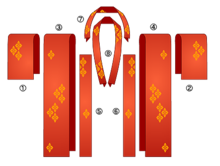
Kimono are traditionally made from a single bolt of fabric known as atanmono,which is roughly 11.5 metres (38 ft) long and 36 centimetres (14 in) wide for women,[1]and 12.5 metres (41 ft) long and 42 centimetres (17 in) wide for men. The entire bolt is used to make one kimono, and some men'stanmonoare woven to be long enough to create a matchinghaorijacket andjubanas well. Kimono linings are made from bolts of the same width.
Some custom bolts of fabric are produced for especially tall or heavy people, such as sumo wrestlers, who must have kimono custom-made by either joining multiple bolts, weaving custom-width fabric, or using non-standard size fabric.[32]For children, in the early 1900s, shorter lengths were used, and sometimes the body of the kimono was made only a single cloth width wide (hitotsumi).[33]Tucks were also used to take in the garment; an outwards-facing pleat at each shoulder (kata-nue-age) and akolpos-like overfold at the hip (koshi-nue-age), so that the child appeared to be wearing a sleeveless vest of the same fabric over their garment. These sewn tucks were let out as the child grew,[31]: 15 and are mostly only seen today on the kimono of apprentice geisha in Kyoto, as apprentices previously began their training at a young age, requiring tucks to be let out as they grew. In the present day, apprentices begin their training in their late teenage years, and the tucks are retained merely as an anachronism.
Though adult women also retained a 'tuck' at the hip, this was a leftover from the trailing length of most women's kimono, which had previously been either held up by hand when walking or tied up loosely with ashigoki obi;though kimono were not worn as trailing towards the end of the 19th century, the excess length of most women's kimono remained, with the hip fold formalised and neatened into theohashoriof the modern day.
Kimono have a set method of construction, which allows the entire garment to be taken apart, cleaned and resewn easily. As theseam allowanceon nearly every panel features twoselvedgesthat will not fray, the woven edges of the fabric bolt are retained when the kimono is sewn, leading to large and often uneven seam allowances; unlike Western clothing, the seam allowances are not trimmed down, allowing for a kimono to be resewn to different measurements without the fabric fraying at the seams.[citation needed]This was also used to prolong the life of the garment by reversing the sleeves (hiding the worn cuff hem in the shoulder seam) or the back panels (swapping the high-stress center seam and the low-stress sides),[34]like the European custom of side-to-middling or end-to-middling bedsheets.
Historically, kimono were taken apart entirely to be washed – a process known asarai-hari.Once cleaned, the fabric would be resewn by hand;[1]this process, though necessary in previous centuries, is uncommon in modern-day Japan, as it is relatively expensive.
Despite the expense of hand-sewing, however, some modern kimono, including silk kimono and all formal kimono, are still hand-sewn entirely; even machine-sewn kimono require some degree of hand-sewing, particularly in finishing the collar, the hem, and the lining, if present. Hand-sewn kimono are usually sewn with a single running stitch roughly 3 millimetres (0.12 in) to 4 millimetres (0.16 in) long, with stitches growing shorter around the collar area for strength. Kimono seams, instead of being pressed entirely flat, are pressed to have a 'lip' of roughly 2 millimetres (0.079 in) (known as thekise) pressed over each seam. This disguises the stitches, as hand-sewn kimono are not tightly sewn, rendering the stitches visible if pressed entirely flat.
Terms
[edit]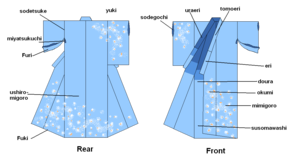
A number of terms are used to refer to the different parts of a kimono. Kimono that are lined are known asawasekimono, whereas unlined kimono are known ashitoekimono; partially lined kimono – with lining only at the sleeve cuff, the back of the sleeve, the lower chest portion of thedōuraand the entirety of thehakkake– are known asdō-bitoe(lit. 'chest-single-layer')kimono.[35]Some fully lined kimono do not have a separate lower and upper lining, and are instead lined with solid panels on theokumi,themaemigoroand theushiromigoro.
These terms refer to parts of a kimono:
- Dōura(Đỗng lí)
- The upper lining of a kimono.
- Hakkake(Bát quải)
- The lower lining of a kimono.
- Eri(Câm)
- The collar.
- Fuki(Nghi)
- The hem guard.
- Furi(Chấn り,lit. 'dangling')
- The part of the sleeve left hanging below the armhole.
- Maemigoro(Tiền thân khoảnh,lit. 'front body')
- The front panels on a kimono, excluding theokumi.The panels are divided into the "rightmaemigoro"and" leftmaemigoro".
- Miyatsukuchi(Thân bát つ khẩu)
- The opening under the sleeve on a woman's kimono.
- Okumi(Nhẫm)
- The overlapping front panel.
- Sode(Tụ)
- The entire sleeve.
- Sodeguchi(Tụ khẩu)
- The wrist opening of the sleeve.
- Sodetsuke(Tụ phó)
- The kimono armhole.
- Susomawashi(Cư hồi し)
- The lower lining.
- Tamoto(Mệ)
- The sleeve pouch of a kimono.
- Tomoeri(Cộng câm,lit. 'over-collar')
- The collar cover sewn on top of theuraeri.
- Uraeri(Lí khâm,lit. 'neckband lining')
- The inner collar.
- Ushiromigoro(Hậu thân khoảnh,lit. 'back body')
- The back panels. The back panels consist of the "rightushiromigoro"and" leftushiromigoro".
Evolution of kimono construction
[edit]

Though the basic shape of the kimono has not changed in centuries, proportions have, historically, varied in different eras of Japanese history. Beginning in the later Heian period, thehitoe– an unlined robe worn as underwear – became the predominant outerwear garment for both men and women, known as thekosode(lit. 'small sleeve').Court-appropriate dress continued to resemble the previous eras.
By the beginning of the Kamakura period, thekosodewas an ankle-length garment for both men and women, and had small, rounded sleeves that were sewn to the body of the garment. Theobiwas a relatively thin belt tied somewhat low on the waist, usually in a plain bow, and was known as ahoso-obi.[36]During this time period, the fashion of wearing akosodedraped around the shoulders, over the head, or as the outermost garment stripped off the shoulders and held in place by theobi,led to the rise of theuchikake– a heavily decorated over-kimono, stemming from the verbuchikake-ru(lit. 'to drape upon'),worn unbelted over the top of thekosode– becoming popular as formal dress for the upper classes.[1]: 39
In the following centuries, thekosodemostly retained its small, narrow and round-sleeved nature, with the length of women's sleeves gradually increasing over time and eventually becoming mostly detached from the body of the garment below the shoulders. The collar on both men's and women'skosoderetained its relatively long and wide proportions, and theokumifront panel kept its long, shallow angle towards the hem. During the Edo period, thekosodehad developed roughly modern kimono proportions, though variety existed until roughly the mid- to later years of the era.[37]Men's sleeves continued to be sewn shut to the body of the kimono down most of their length, with no more than a few inches unattached at the bottom, unlike the women's style of very deep sleeves mostly detached from the body of the kimono. Men's sleeves were also less deep than women's kimono sleeves so that they did not get tied under the narrowobiaround the hips, whereas on a woman's kimono, the long, unattached bottom of the sleeve could hang over the widerobiwithout getting in the way.[38]Sleeves for both men and women grew in proportion to be of roughly equal width to the body panels, and the collar for both men's and women's kimono became shorter and narrower.
In the present day, both men's and women's kimono retain some historical features – for instance, women's kimono trailed along the floor throughout certain eras, and when the wearer went outside, the excess length would be tucked and tied underneath theobiin a hip fold known as theohashori.Theohashoriis now used for fine length adjustments,[39]and takes up 7–10 inches (18–25 cm) of excess length.[38]A hand-sewn tuck across the back under theobiis used for coarse adjustments, and made deliberately weak so that the stitches will tear before the cloth does under tension.[39]Men's kimono, on the other hand, are cut to the length of the wearer's body and tied with a narrow belt at the hips, with no extra fabric in the kimono's length for an overfold at the hip.
Formal women's kimono also retain the wider collar of previous eras (made from a fulltanmono-width instead of a half width), though it is always folded in half lengthwise before wearing – a style known ashiro-eri(lit. 'wide collar',as opposed tobachi-eri,a normal width collar).[40]
Women's kimono are still worn trailing in some situations, such as onstage, in historical dramas, and by geisha andmaiko.In these instances, the kimono worn is constructed differently to a regular women's kimono: the collar is set back further into the neck, the sleeves are sewn to the body unevenly (further down the front than the back), and the body is elongated. This style of kimono is referred to as asusohikiorhikizuri.Though the length of the kimono, collar style and sleeve construction differs for this type of kimono, in all other types of women's kimono, the construction is generally the same; the collar is set back only slightly into the nape of the neck, the sleeves are attached evenly only at the shoulder (not all the way down the sleeve length) and the kimono's length from shoulder to hem is ideally the entire height of the woman wearing it, to allow for the creation of theohashori.
Sleeve length
[edit]The sleeve length (dropping down from the arm towards the floor when held outstretched) varies in kimono.
| Type | Sleeve length | Use |
|---|---|---|
| Men's sleeves | Men's sleeves are not visual markers of youth. They are attached to the body of the kimono all the way down, or almost all of the way down; though a small portion perhaps a few centimetres in length may be left unattached to the body at the very bottom, this portion is sewn closed. The construction of men's kimono sleeves reflects the fact that they do not have to accommodate the widerobiworn by women. | |
| Tomesode,ordinary women's sleeves | 49 cm (19 in), or hip-length[41] | Usual women's length; this was longer pre-WWII, but was shortened due to rationing.[34][41]This is the length almost invariably used foryukata,and used by definition for every type oftomesodekimono. |
Furisode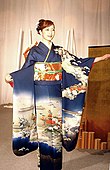 |
Furisode(Chấn tụ,lit. 'swinging sleeve')kimono are worn by young, typically unmarried, women. In the present day, the termfurisoderefers by definition to highly-formal long-sleeved kimono worn by girls and young women; however, informal kimono such asyukatawithfurisode-length sleeves are sometimes seen. In the past, mostly all young women wore long-sleeved kimono as a marker of youth generally regardless of the formality of their kimono, and upon marriage, women would cut or hem their sleeves shorter, or unpick the sleeves and swap them for an identical but shorter pair.Furisodewere historically worn by all children, with no gender distinction in pattern or cut, but it is now only young girls who are dressed infurisode.[33] | |
| Ko-furisode(also callednisyakusode)[42]( "short" ) | 76–86 cm (30–34 in)[42] | Divided intokuro-furisodeandiro-furisode,these are parallel versions of the formal, shorter-sleevedkurotomesodeandirotomesode,but with longer sleeves. Ako-furisodewith akomon-style pattern is deemed casual wear.Ko-furisodeare also worn withhakama.In the modern era,ko-furisodeare rare, but are sometimes worn for graduations. Mostko-furisodeare vintage kimono, as in the modern dayfurisodeare not worn often enough to warrant buying a more casual form of the dress.[43] |
| Tyu-furisode[42]orchu-furisode( "mid-size" ) | 86–115 cm (34–45 in), or shoulder to calf;[42]usually about 100 cm (39 in) | Tyu-furisodeare suitable for most formal occasions; the sleeve length oftyu-furisodehas been growing longer, due to growing people and the near-elimination ofō-furisode,and may be consideredō-furisode.[43]Tyu-furisodeare worn toseijin shiki(Coming of Age Day) or weddings, either by the bride herself or an unmarried younger female relative. |
| Ō-furisode[42]orhon-furisode | 114–115 cm (45–45 in), as high as 125 cm (49 in), or shoulder to ankle[42] | Generally only worn by brides, dancers, and singers. The hem of theō-furisodeis padded so it can trail. |
Cost
[edit]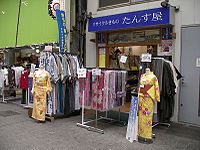
Both men's and women's brand-new kimono can range in expense (in 2023) from around ¥1000 (~$7 USD) to ¥150,000 (~$1050 US)[44]
The high expense of some hand-crafted brand-new kimono reflects the traditional kimono making industry, where the most skilled artisans practice specific, expensive and time-consuming techniques, known to and mastered only by a few. These techniques, such as hand-pliedbashofufabrics and hand-tiedkanoko shiboridotwork dyeing, may take over a year to finish. Kimono artisans may be madeLiving National Treasuresin recognition of their work, with the pieces they produce being considered culturally important.
Even kimono that have not been hand-crafted will constitute a relatively high expense when bought new, as even for one outfit, a number of accessories of the right formality and appearance must be bought. Not all brand-new kimono originate from artisans, and mass-production of kimono – mainly of casual or semi-formal kimono – does exist, with mass-produced pieces being mostly cheaper than those purchased through agofukuya(kimono shop).
Though artisan-made kimono are some of the most accomplished works of textile art on the market, many pieces are not bought solely for appreciation of the craft. Unwritten social obligations to wear kimono to certain events – weddings, funerals – often leads consumers to purchase artisan pieces for reasons other than personal choice, fashion sense or love of kimono:
[Third-generationyūzendyer Jotaro Saito] believes we are in a strange age where people who know nothing about kimono are the ones who spend a lot of money on a genuine handcrafted kimono for a wedding that is worn once by someone who suffers wearing it, and then is never used again.[45]: 134
The high cost of most brand-new kimono reflects in part the pricing techniques within the industry. Most brand-new kimono are purchased throughgofukuya,where kimono are sold as fabric rolls only, the price of which is often left to the shop's discretion. The shop will charge a fee separate to the cost of the fabric for it to be sewn to the customer's measurements, and fees for washing the fabric or weatherproofing it may be added as another separate cost. If the customer is unfamiliar with wearing kimono, they may hire a service to help dress them; the end cost of a new kimono, therefore, remains uncertain until the kimono itself has been finished and worn.[20]
Gofukuyaare also regarded as notorious for sales practices seen as unscrupulous and pressuring:
Many [Japanese kimono consumers] feared a tactic known askakoikomi:being surrounded by staff and essentially pressured into purchasing an expensive kimono [...] Shops are also renowned for lying about the origins of their products and who made them [...] [My kimono dressing (kitsuke) teacher] gave me careful instructions before we entered the [gofukuya]: 'do not touch anything. And even if you don't buy a kimono today, you have to buy something, no matter how small it is.'[20]: 115–117
In contrast, kimono bought by hobbyists are likely to be less expensive, purchased from second-hand stores with no such sales practices or obligation to buy. Hobbyists may also buy cheaper synthetic kimono (marketed as 'washable') brand-new. Some enthusiasts also make their own kimono; this may be due to difficulty finding kimono of the right size, or simply for personal choice and fashion.
Second-hand items are seen as highly affordable; costs can be as little as ¥100 (about US$0.90)[citation needed]at thrift stores within Japan, and certain historic kimono production areas around the country – such as theNishijindistrict of Kyoto – are well known for their second-hand kimono markets. Kimono themselves do not go out of fashion, making even vintage or antique pieces viable for wear, depending on condition.[46]
However, even second-hand women'sobiare likely to remain somewhat pricey; a used, well-kept and high-quality second-handobican cost upwards of US$300,[citation needed]as they are often intricately woven, or decorated with embroidery, goldwork and may be hand-painted. Men'sobi,in contrast, retail much cheaper, as they are narrower, shorter, and have either very little or no decoration, though high-end men'sobican still retail at a high cost equal to that of a high-end women'sobi.
Types of kimono
[edit]Several different types of kimono exist. These varieties are primarily based on formality and gender, with more women's varieties of kimono existing than men's.
The modern kimono canon was roughly formalised after WWII, following fabric shortages, a generation unfamiliar with wearing kimono in everyday life, and the postwar revival of kimono sales bygofukuya,traditional kimono shops. In previous centuries, types of kimono were not as distinct, with factors such as age and social class playing a much larger role in determining kimono types than they do presently. Beginning in the Meiji period, and following the Meiji Restoration and the abolition of class distinctions, kimono varieties began to change as Japanese society did, with new varieties being invented for new social situations.
Formality
[edit]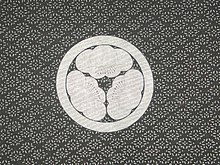
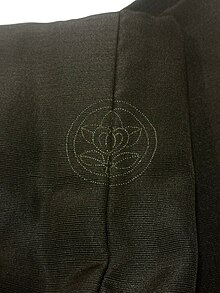
Kimono range in variation from extremely formal to very casual. For women, the formality is determined mostly by pattern placement, decoration style, fabric choice and colour. For men, whose kimono are generally monochromatic, formality is determined typically by fabric choice and colour. For both men and women, the accessories andobiworn with the kimono also determine formality.
The formality levels of different types of kimono are a relatively modern invention, having been developed between late Meiji- to post-war Japan, following the abolition of Edo-period sumptuary clothing laws in 1868.[47]These laws changed constantly, as did the strictness with which they were enforced, and were designed to keep the nouveau riche merchant classes from dressing above their station, and appearing better-dressed than monetarily-poor but status-richsamuraiclass.
Colours and patterns
[edit]Under feudal sumptuary laws, colours were restricted by class; for instance,indigo-dyed clothing was allowed for all classes, and was commonly seen in hand-dyed cotton, linen or hempkasurifabrics, but other dyes, such as reds and purples, were forbidden to those below a certain class. Sometimes, for some classes, designs were restricted to below the belt, to the bottoms of the sleeves (forfurisode) or to along the hem (suso-moyo); sometimes they were banned altogether,[39]and were transferred to the collar of the underkimono,[48]or the inside of the hem, where only the faintest glimpse would be intermittently visible. This type of subtle ostentation became an aesthetic known asiki,and outlasted the sumptuary laws.[39]Modern-day rules of formality, however, still echo clothing distinctions typically employed by the uppermost samurai classes.[39]
Aspects of men's kimono still follow this extreme ofiki.Bright, elaborate decoration is used on the lining of thehaori(jacket), and on men'sjuban(underkimono), which is not worn as an outer layer outside the home, and so only shows at the neck and inside the sleeves. Women'sjubanwere once bright and boldly-patterned (and were often kimono too damaged to use as an outer layer, repurposed), but are now typically muted pastel shades.[38][34]The outside of men's garments tended towards subtle patterns and colours even after the sumptuary laws lifted, with blues and blacks predominating, but designers later came to use browns, greens, purples, and other colours in increasingly bold patterns.
Older people generally wear more subtle patterns, and younger people brighter, bolder ones.
Fabric type
[edit]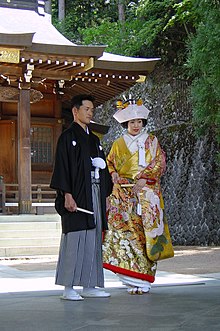
Kimono vary widely in fabric type, and are not all made of silk. Certain types of fabric, such as wool, cotton, linen and hemp, are always considered informal, and so are not seen on more formal varieties of kimono. Certain varieties of silk, such astsumugi,are considered informal,[49]having once been woven only by silk farmers out of unusable cocoons for their own use; other, more modern varieties, such asmeisen,were designed to be used as casual, cheap daywear, and are machine-spun and -woven using brightly-patterned yarns. Some varieties of crêpe are on the lowest end of formal, with their rougher texture considered unsuitable for formal use;[49]other varieties, such as smooth crêpe, are used for all varieties of formal kimono. The most formal kimono are only ever made of smooth, fine silks, such as glossy silk fabrics likehabutai.
Some fabrics are also worn only at certain times of year;ro,for instance, is a plain-weave fabric withleno weavestripes only worn in high summer (July and August), but is used for all types of kimono and for other garments, such as under-kimono andobi.[48][38]Some fabrics – such as certain types of crêpe – are never seen in certain varieties of kimono,[b]and some fabrics such asshusu(heavy satin) silk are barely ever seen in modern kimono orobialtogether, having been more popular in previous eras than in the present-day.
Despite their informal nature, many types of traditional, informal kimono fabrics are highly-prized for their craftsmanship. Varieties oftsumugi,kasuri,and fabrics woven fromMusa basjooare valued for their traditional production, and regularly command high prices.
Lined and unlined kimono
[edit]In the summer months (from June[50]until October[26]in the most stringent kimono guides, such as those for tea ceremony), kimono are unlined (hitoe); for the rest of the year, they are lined (awase). This applies to all types of kimono, with a few caveats: the very informalyukatais always unlined, and thus only worn in summer; the most formal kimono, in contrast, are unlikely to be worn unlined in summer, as many people simply do not have more than one formal kimono to wear, and do not wear formal kimono often enough to warrant the purchase of a new, unlined kimono, just for summer wear.Obialso change fabric type in the summer months.
Within the two realms of lined and unlined, further distinctions exist for different months. Lined kimono are either made from transparent or gauze fabrics (usu-mono) or opaque fabrics, with kimono transitioning towards gauze fabrics at the height of summer and away from them as autumn begins. In one kimono guide for tea ceremony, at the start of the unlined season in June, fabrics such askawari-chirimen(a type of silk crêpe noted as a more "wrinkle-resistant" form ofhitokoshi-chirimen) andkomayori ro(a thicker type ofrowith twisted silk threads) are recommended for wear.[50]Following the beginning of therainy seasonin some time in July, fabrics switch over to gauzier varieties, and highly-prized hemp fabrics such asEchigo-jofuare worn.[51]Continuing into August, hemp,roandshacontinue to be worn; in September, they are still worn, but fabrics such ashitokoshi chirimen,worn in June, become suitable again, and opaque fabrics become preferred over sheer, though sheer may still be worn if the weather is hot.[26]
In the same kimono guide, the first lined kimono are worn in October, and the transition away from plainer opaque fabrics to richer silks such asrinzuis immediate. The richness of fabrics increases going into November and December, with figured silks featuring woven patterns appropriate. Coming into January, crêpe fabrics with a rougher texture become appropriate, with fabrics such astsumugiworn in February.[26]Figured silks continue to be worn until June, when the unlined season begins again. In Japan, this process of changing clothes is referred to askoromogae.
Crests
[edit]Formality is also determined by the number and type ofmonorkamon(crests). Five crests (itsutsu mon) are the most formal, three crests (mitsu mon) are mid-formality, and one crest (hitotsu mon) is the least formal, used for occasions such as tea ceremony. Kimono (and other garments, likehakama) withmonare calledmontsuki( "mon-carrying "). The type of crest adds formality as well. A" full sun "(hinata) crest, where the design is outlined and filled in with white, is the most formal type. A "mid-shadow" (nakakage) crest is mid-formality, with only the outline of the crest visible in white. A "shadow" (kage) crest is the least formal, with the outline of the crest relatively faint. Shadow crests may be embroidered onto the kimono, and full-embroidery crests, callednui mon,are also seen.[52]
Choice of accessories
[edit]Formality can also be determined by the type and colour of accessories. For women, this may be the weave ofobijimeand the style ofobiage.[citation needed]For men, adding ahaori(a traditional jacket) makes an outfit more formal, and adding bothhaoriandhakama(traditional trousers) is more formal still. The material, colour, and pattern of these overgarments also varies in formality.[49]Longerhaoriare also more formal.
Sleeve length and construction
[edit]Both men's and women's kimono feature sleeves considered relatively short, with men's sleeves shorter than women's. Though lengths can vary by a few centimetres, these lengths are informally standardised.
Men's kimono sleeves are only ever one length, and women's sleeves are limited to a short length suitable for almost all types of kimono, or a longer length used for only one type of formal young women's kimono. In the modern day, the two lengths of women's sleeve worn on kimono arefurisodelength, which almost reaches the floor, and a shorter length, used for every other variety of women's kimono.
Before WWII, the length of women's kimono sleeves varied, with sleeves gradually shortening as a woman got older. During WWII, due to shortage of fabric, the 'short' length of women's kimono sleeves became standardised, and post-WWII, the realm of long kimono sleeves was narrowly curtailed to the realm offurisodeonly – formal young women's and girl's kimono, where previously longer sleeves were seen on other varieties of dress, both formal and informal. Pre-WWII women's kimono are recognisable for their longer sleeves, which, though notfurisodelength, are longer than most women's kimono sleeves today.
Young women are not limited to wearing onlyfurisode,and outside of formal occasions that warrant it, can wear all other types of women's kimono which feature shorter sleeves.
General types of kimono
[edit]Juban
[edit]Thejuban,also referred to as thenagajuban,is an under-kimono worn by both men and women.Jubanresemble a kimono in construction, with a few key differences: the sleeves are typically open along the entire cuff side, with only a few stitches sewing both sides together placed where a normal kimono sleeve cuff would end; the sleeve has no curve sewn into the outer edge, instead being square; thejubanis typically a little shorter than the length of a kimono when worn, and features no extra length to be bloused into anohashorifor women's kimono; the front either does not have any overlapping panels (okumi) or features only thin ones, with the collar set at a lower angle than that of a regular kimono.Jubanare considered an essential piece of kimono underwear, and are worn with all types of kimono except foryukata.
Jubanare typically made of lightweight materials, often silk. Women'sjubanand can either be patterned or entirely plain, and modern women'sjubanare frequently white in colour.
Men'sjubanare often dyed in dark colours, and can be made of the same material as the outer kimono, as some kimono fabric bolts (tanmono) are woven with enough length to accommodate this. Men'sjubanare frequently more decorative than women's, often featuring a dyed pictorial scene in the upper back, such as a scene fromThe Tale of Genji.
In the late 19th and early 20th century, women'sjubantransitioned from being mostly red with bold white motifs to being white or light pastel colours. The dye technique previously used to achieve this,beni itajime,fell out of fashion and knowledge and was rediscovered in 2010.[53]: 1
Hadajuban
[edit]Hadajubanare a type of kimono undergarment traditionally worn underneath thenagajuban.Hadajubanare even further removed from resembling a kimono in construction than thenagajuban;thehadajubancomes in two pieces (a wrap-front top and a skirt), features no collar, and either has tube sleeves or is sleeveless.
Unlike thenagajuban,thehadajubanis not considered an essential piece of kimono underwear, and a t-shirt and shorts are frequently substituted in its place.
Yukata
[edit]
Yukata(Dục y)are casual cotton summer kimono worn by both men and women.Yukatawere originally very simple indigo and white cotton kimono, little more than a bathrobe worn either within the house, or for a short walk locally;yukatawere also worn by guests at inns, with the design of theyukatadisplaying the inn a person was staying at. From roughly the mid-1980s onwards, they began to be produced in a wider variety of colours and designs, responding to demand for a more casual kimono that could be worn to a summer festival, and have since become more formal than their previous status as bathrobes, with high-end, less colourfulyukatasometimes standing in place ofkomon.
In the present day, manyyukataare brightly coloured, featuring large motifs from a variety of different seasons. For women, they are worn with either ahanhaba obi(half-widthobi) or aheko obi(a soft, sash-likeobi), and are often accessorised with colourful hair accessories. For men,yukataare worn with either an informalkaku obior aheko obi.Children generally wear aheko obiwithyukata.
Yukataare always unlined, and it is possible for women to wear a casualnagoya obiwith a high-end, more subduedyukata,often with ajubanunderneath. A high-end men'syukatacould also be dressed up in the same way.
Ayukatais traditionally worn as a single layer or over ahadajuban(an underkimono worn underneath thenagajuban,featuring a simplified construction).Yukatamay also be worn over the top of a t-shirt and shorts. This distinguishesyukatafrom a more-formalkomonkimono, where anagajuban(also simply referred to as ajuban,an underkimono resembling) is worn underneath, showing a second layer of collar at the neckline. However, some modernyukataare worn with collared cottonjubanfeaturing a collar of linen, cotton orro,for occasions such as informal eating-out.[38][34]
Tsumugi
[edit]
Tsumugi(Trừu)are casual silk kimono worn by both men and women.Tsumugikimono traditionally referred to kimono woven in plain weave withsilk noil,short-staplesilk fibre, though now include various types of casual silk kimono whereby the pattern is produced by weave as opposed to surface dying.[54]Tsumugikimono are often dyed withKasuripatterns.[55]
Komon
[edit]
Komon(Tiểu văn,lit. 'small pattern',though the patterns may in fact be large)are informal women's kimono. They were the type most often worn as everyday womenswear in pre-war Japan. Though informal,komonwith smaller, denser patterns are considered a shade more formal thankomonwith larger, bolder patterns.
Komonmostly have nokamon(crests), and the sleeves are fairly short. They are made with a repeating designs, though the repeat length may be quite long. Designs can be made with any method; woven patterns, prints, stencilled patterns in alternating orientations, freehand painting (yūzen) or tie-dye patterns (shibori). Traditionally the direction of the fabric was alternated in adjacent panels (necessary due to the lack of shoulder seam), so patterns were generally reversible. If the pattern is the same way up on each panel, thekomonis more formal, approachingtsukesage-level formality.[citation needed]
Woven geometric patterns (such as stripes) have no season, but others show images representing the season in general. Woven non-geometric patterns (kasuri) are also common. Small, dense patterns are often used; this is practical, as fine-scale patterns hides stains.
Komonare made with informal materials such astsumugi(slubbed silk), cotton, linen, ramie, and hemp. In the modern day, synthetic blends and synthetics are also used; rayon (jinken) and polyester are common.
Now that kimono are not typically worn as informal clothing,komonare not worn as often as formal kimono, though they have a wider range of suitable use.Edo komonare the most formal type ofkomon;they may have one to three crests, with a small, fine pattern that appears to be a solid colour from a distance, and so resembles the more formaliromuji.
Edo komon
[edit]
Edo komon(Giang hộ tiểu văn)are a type ofkomonworn by women characterised by an extremely small repeating pattern, usually done in white on a coloured background. Theedo komondyeing technique is sometimes said to originate in the late Heian period (circa mid-12th century), with a motif calledkozakura,which shows tiny stylised cherry blossoms on a background of white dots. In theEdo period(1603–1867), thesamuraiclasses used them forkamishimoformal wear, with specific patterns becoming associated with specific families. Towards the end of the Edo period, in the early 1800s, commoners began to wear them.[56]Edo komonare of a similar formality toiromuji,andedo komonwith onekamoncan be worn as low-formality visiting wear; because of this, they are always made of silk, unlike regularkomon.
Iromuji
[edit]
Iromuji(Sắc vô địa,lit. 'solid colour')are monochromatic, undecorated women's kimono mainly worn to tea ceremonies, as the monochrome appearance is considered to be unobtrusive to the ceremony itself. Despite being monochromatic,iromujimay feature a woven design;iromujisuitable for autumn are often made ofrinzudamask silk. Someedo komonwith incredibly fine patterns are also considered suitable for tea ceremony, as from a distance they are visually similar toiromuji.Iromujimay occasionally have onekamon,though likely no more than this, and are always made of silk.Shiboriaccessories such asobiageare never worn withiromujiif the purpose of wear is a tea ceremony; instead, flat and untextured silks are chosen for accessories.
Tsukesage
[edit]
Tsukesage(Phó け hạ げ)are low-ranking women's formalwear, and are a step belowhōmongi,though the two sometimes appear similar or indistinguishable. The motifs on atsukesageare placed similarly to those of ahōmongi– across the back-right shoulder and back-right sleeve, the front-left shoulder and the front-left sleeve, and across the hem, higher at the left than the right – but, unlikehōmongi,do not typically cross over the seams of each kimono panel, though some confusingly do. In older examples, the motifs may instead be placed symmetrically along the hem, with the skirt patterns mirrored down the centre-back seam.[39]
Similarities betweentsukesageandhōmongioften lead to confusion, with sometsukesageindistinguishable fromhōmongi;often,tsukesageare only distinguishable fromhōmongiby the size of the motifs used, with smaller, less fluid motifs generally considered to betsukesage,and larger, more fluid motifs considered to behōmongi.[57]
Tsukesagecan have between one and threekamon,and can be worn to parties, but not ceremonies or highly formal events.
Hōmongi
[edit]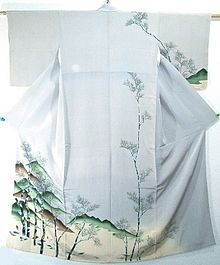
Hōmongi(Phóng vấn trứ,lit. 'visiting wear')are women's formal kimono with the same pattern placement as atsukesage,but with patterns generally matching across the seams. They are always made of silk, and are considered more formal than thetsukesage.
Hōmongiare first roughly sewn up, and the design is sketched onto the fabric, before the garment is taken apart to be dyed again. Thehōmongi's close relative, thetsukesage,has its patterns dyed on the bolt before sewing up. This method of production can usually distinguish the two, as the motifs on ahōmongiare likely to cross fluidly over seams in a way atsukesagegenerally will not.[57]However, the two can prove near-indistinguishable at times.
Hōmongimay be worn by both married and unmarried women; often friends of the bride will wearhōmongito weddings (except relatives) and receptions. They may also be worn to formal parties.
Irotomesode
[edit]
Irotomesode(Sắc lưu tụ,lit. 'colour short-sleeve')are formal women's kimono that feature a design along the hem on a coloured background. They are slightly less formal thankurotomesode,which have roughly the same pattern placement on a black background.Irotomesode,though worn to formal events, may be chosen when akurotomesodewould make the wearer appear to be overdressed for the situation. The pattern placement forirotomesodeis roughly identical tokurotomesode,though patterns seen along thefukiandokumimay drift slightly into the back hem itself.Irotomesodewith fivekamonare of the same formality as anykurotomesode.Irotomesodemay be made of figured silk such asrinzū.
Iro-montsuki
[edit]Iro-montsuki(lit. 'colourmon-decorated')are formal men's kimono.Iro-montsukifeature formal crests along the shoulders on a colour background, which, apart from the cut of the sleeve, appears the same as anirotomesodefrom the waist up, and thus cannot be distinguished in pattern when worn under thehakama.[49]Because formalwear for men requireshakama,[49]men do not wear formal kimono that have elaborate patterns on the hem, as these would be hidden.[58]
Kurotomesode
[edit]
Kurotomesode(Hắc lưu tụ,lit. 'black short-sleeve')are formal women's kimono, featuring a black background and a design along the hem. They are the most formal women's kimono, and are worn to formal events such as weddings and wedding parties. The design is only present along the hem; the further up the body this design reaches, the younger the wearer is considered to be, though for a very young woman anirotomesodemay be chosen instead,kurotomesodebeing considered somewhat more mature. The design is either symmetrically placed on thefukiandokumiportions of the kimono, or asymmetrically placed along the entirety of the hem, with the design being larger and higher-placed at the left side than the right. Vintage kimono are more likely to have the former pattern placement than the latter, though this is not a hard rule.
Kurotomesodeare always made of silk, and may have ahiyoku– a false lining layer – attached, occasionally with a slightly padded hem. Akurotomesodeusually has between 3 and 5 crests; akurotomesodeof any number of crests outranks anirotomesodewith less than five.Kurotomesode,though formalwear, are not allowed at the royal court, as black is the colour of mourning, despite the colour designs decorating the kimono itself;[citation needed]outside of the royal court, this distinction forkurotomesodedoes not exist.Kurotomesodeare never made of flashy silks such asrinzū,but are instead likely to be a matte fabric with little texture.
Kurotomesodetypically featurekazari jitsuke(Sức り sĩ phó け),small white decorative prickstitches along the collar.
Kuro-montsuki
[edit]Kuro-montsuki( "blackmon-decorated ") are the most formal men's kimono, which, apart from the cut of the sleeve, look exactly the same from the waist up as akurotomesode,and thus cannot be distinguished in pattern when worn under thehakamarequired for men's formal dress.[49]
Occasion-specific types
[edit]Mofuku
[edit]Mofuku(Tang phục)are a category of kimono and kimono accessories suitable for mourning, worn by both men and women.Mofukukimono,obiand accessories are characterised by their plain, solid black appearance.Mofukukimono are plain black silk with fivekamon,worn with white undergarments and whitetabi.Men wear a kimono of the same kind, with a subduedobiand a black-and-white or black-and-grey stripedhakama,worn with black or white zōri.
A completely black mourning ensemble for women – a plain blackobi,blackobijimeand blackobiage– is usually reserved for those closest to the deceased. Those further away will wear kimono in dark and subdued colours, rather than a plain black kimono with a reduced number of crests. In time periods when kimono were worn more often, those closest to the deceased would slowly begin dressing in coloured kimono over a period of weeks after the death, with theobijimebeing the last thing to be changed over to colour.[1]
Uchikake
[edit]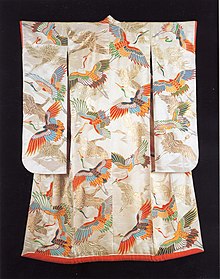
Uchikake(Đả ち quải け)are highly formal women's over-kimono, worn only by brides or onstage. The nameuchikakecomes from theJapaneseverbuchikake-ru,"to drape upon", originating in roughly the 16th century from a fashion among the ruling classes of the time to wear kimono (then calledkosode,lit. 'small sleeve') unbelted over the shoulders of one's other garments;[1]: 34 theuchikakeprogressed into being an over-kimono worn by samurai women before being adopted some time in the 20th century as bridal wear.
Uchikakeare designed to be worn over the top of a complete kimono outfit withobi,and thus are not designed to be worn belted. Unlike their 16th century counterparts, modernuchikakegenerally could not double as a regular kimono, as they often feature heavy, highly-formal decoration and may be padded throughout, if not solely on the hem. They are designed to trail along the floor, and the heavily-padded hem helps to achieve this.
Bridaluchikakeare typically red or white, and often decorated heavily with auspicious motifs. Because they are not designed to be worn with anobi,the designs cover the entirety of the back.
Shiromuku
[edit]
Shiromuku(Bạch vô cấu,lit. 'white pure-innocence')are pure-white wedding kimono worn by brides for a traditionalJapaneseShintowedding ceremony.Comparable to anuchikakeand sometimes described as a whiteuchikake,theshiromukuis worn for the part of the wedding ceremony, symbolising the purity of the bride coming into the marriage. The bride may later change into a reduchikakeafter the ceremony to symbolise good luck.
Ashiromukuwill form part of a bridal ensemble with matching or coordinating accessories, such as a bridalkatsura(bridal wig), a set of matchingkanzashi(usually mock-tortoiseshell), and asensufan tucked into the kimono. Due to the expensive nature of traditional bridal clothing, few are likely to buy brand-newshiromuku;it is not unusual to rent kimono for special occasions, and Shinto shrines are known to keep and rent outshiromukufor traditional weddings. Those who do possessshiromukualready are likely to have inherited them from close family members.
Susohiki/Hikizuri
[edit]
Susohiki(lit. 'trailing skirt') (also known ashikizuri) are women's kimono with a specialised construction that allows them to be worn trailing, with a deep-set and widely-spaced collar.Susohikiare extremely long kimono worn by geisha,maiko,actors inkabukiand people performingtraditional Japanese dance.Asusohikican be up to 230 cm (91 in) long, and are generally no shorter than 200 cm (79 in) from shoulder to hem; this is to allow the kimono to trail along the floor.
Susohikiare sewn differently to normal kimono due to the way they are worn.[59]The collar on asusohikiis sewn further and deeper back into the nape of the neck, so that it can be pulled down much lower without causing the front of the kimono to ride up. The sleeves are set unevenly onto the body, shorter at the back than at the front, so that the underarm does not show when the collar is pulled down.
Susohikiare also tied differently when they are put on – whereas regular kimono are tied with a visibleohashori,and the side seams are kept straight,susohikiare pulled up somewhat diagonally, to emphasise the hips and ensure the kimono trails nicely on the floor. A smallohashoriis tied, larger at the back than the front, but it wrapped against the body with amomi(lit. 'red silk') wrap, which is then covered by theobi,rendering theohashoriinvisible.[c]
Aside from their specialised construction,susohikican resemble many other types of women's kimono in their decoration, fabric type, colour and sleeve length. Thesusohikiworn by geisha and their apprentices are formal kimono worn to engagements, and so are always made of fine silk, resembling kimono ofhōmongiformality and above in their pattern placement and background colour.
Thesusohikiworn by kabuki actors varies by role, and so can appear as the humble clothing of an Edo-period merchant's daughter, as well as the fine silk clothing of a samurai woman. These costumes may be made of polyester, as well as silk, informal silk fabrics, cotton, linen or hemp. Pattern placement, colour and design varies by role, with many roles having costume designs preserved from previous centuries.
Thesusohikiworn by people performing traditional Japanese dance typically feature a bold design in block colours, as their clothing must stand out from the stage. Performers performing in a group wear kimono identical to one another, with the bold designs creating visual unity between performers.
Related garments and accessories
[edit]Though the kimono is the national dress of Japan, it has never been the sole item of clothing worn throughout Japan; even before the introduction of Western dress to Japan, many different styles of dress were worn, such as theattusof theAinu peopleand theryusouof the Ryukyuan people. Though similar to the kimono, these garments are distinguishable by their separate cultural heritage, and are not considered to be simply 'variations' of kimono such as the clothing worn by the working class is considered to be.
Some related garments still worn today were the contemporary clothing of previous time periods, and have survived on in an official and/or ceremonial capacity, worn only on certain occasions by certain people.
There are a number of accessories that can be worn with the kimono, and these vary by occasion and use. Some are ceremonial, or worn only for special occasions, whereas others are part of dressing in kimono and are used in a more practical sense.
Bothgeishaandmaikowear variations on common accessories that are not found in everyday dress. As an extension of this, many practitioners ofJapanese traditional dancewear similar kimono and accessories to geisha andmaiko.
For certain traditional holidays and occasions some specific types of kimono accessories are worn. For instance,okobo,also known aspokkuri,are worn by girls forshichi-go-san,alongside brightly colouredfurisode.Okoboare also worn by young women onseijin no hi(Coming of Age Day).
Layering
[edit]Pre-WW2, kimono were commonly worn layered, with three being the standard number of layers worn over the top of undergarments. The layered kimono underneath were known asdōnuki,and were often a patchwork of older or unwearable kimono taken apart for their fabric. Specifically-designed matching sets of formal layered kimono were known aso-tsui,and generally featured the same design presented on different background colours, such as white (innermost), red (middle layer) and black (outermost).[22]: 42 The innermost layers, known asshitagi,typically featured the plainest decorative techniques, such as dyework only, and the successive outer layers would feature techniques such as embroidery and couched gold thread, with the outermost layer – known as theuwagi– displaying the most extensive decoration.[22]: 45 These matching sets would be designed and created together, commonly as part of a bride's outfit for a wedding. Extant intact sets ofo-tsuikimono are difficult to find, particularly in good condition, with the innermost kimono typically damaged and in poor condition.[22]: 46
In modern Japan, at least one layer is typically worn next to the skin when wearing kimono. Traditionally, this would be thehadagiorhadajuban,a tube-sleeved, wrapped-front garment considered to be underwear, though in the modern day, regular underwear is sometimes worn instead, and a traditionalhadajubanis not considered strictly necessary. Ahadajubanis typically made of something more washable than silk, such as cotton, hemp, linen or some synthetic fibres.
For all forms of kimono except theyukata(excluding high-qualityyukatadressed up askomon), anagajuban(lit. 'longjuban'),often known and referred to as ajuban,is worn over the top of any underwear. Thejubanresembles a kimono made of a lighter, thinner fabric, not uncommonly constructed without anokumipanel at the front, and often has a collar cover known as ahan'erisewn over its collar. Thehan'eri,which is visible at the neckline when worn underneath a kimono, is designed to be replaced and washed when needed.[38]
In modern-day Japan, layered kimono are generally only seen on the stage, whether for classical dances or in kabuki. A false second layer called ahiyoku(Bỉ dực,"second wing" )may be attached instead of an entirely separate kimono to achieve this look; thehiyokuresembles the lower half of a kimono's lining which, and is sewn to the kimono horizontally along the back. Ahiyokumay have a false collar attached to it, or a matching false collar sewn to the kimono separately, creating the illusion of a layered kimono at the neckline; separate false sleeve cuffs may also be sewn into the kimono to create this effect.
Kimono featuringhiyokucan be seen in some kabuki performances such asFuji Musume,where the kimono is worn with theokumiflipped back slightly underneath theobito expose the design on thehiyoku.Thehiyokucan also be seen on some bridal kimono.
Care
[edit]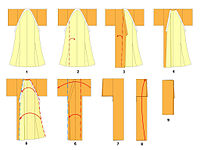
In the past, a kimono would often be entirely taken apart for washing, and then re-sewn for wearing.[24]This traditional washing method involves two steps: taking the kimono apart and washing each piece (toki arai) and then stretching each piece of a kimono onto a board to dry after they have been washed and starched (arai hari).[61]Because the stitches must be taken out for washing, traditional kimono need to be hand sewn. The process of traditionally washing kimono is very expensive and difficult and is one of the causes of the declining popularity[citation needed]of kimono. Modern fabrics and cleaning methods have been developed that eliminate this need, although the traditional washing of kimono is still practiced, especially for high-end garments.
New, custom-made kimono are generally delivered to a customer with long, loosebastingstitches placed around the outside edges. These stitches are calledshitsuke ito(not to be confused withkazari jitsuke,the small white prickstitching seen along the collar ofkurotomesode). They are sometimes replaced for storage. They help to prevent bunching, folding and wrinkling, and keep the kimono's layers in alignment.
Like many other traditional Japanese garments, there are specific ways to fold kimono. These methods help to preserve the garment and to keep it from creasing when stored. Kimono are often stored wrapped in acid-free paper envelopes known astatōshi.
Kimono need to beaired outat least seasonally and before and after each time they are worn. Many people prefer to have their kimonodry cleaned.Although this can be extremely expensive, it is generally less expensive than the traditional method of taking a kimono apart to clean it. This may, however, be impossible for certain fabrics or dyes.
Sanchi,kimono production regions
[edit]Kimono are produced in different regions all over Japan. Locations known for making kimono are often calledsanchi.Many of these regional variations still exist today and are recognized asmeibutsu,famous products of their place of origin.
| Name | Kanji | Location | Notes | Example image | |
|---|---|---|---|---|---|
| Kumejima-tsumugi | Cửu mễ đảo trừu | Kumejima, Okinawa | |||
| Miyako Jofu | Cung cổ thượng bố | Miyako, Okinawa | |||
| Oitama | Trí tứ | Yamagata | Including:
|
||
| Shiozawa tsumugi | Diêm trạch đảo trừu | Shiozawa, Niigata | |||
| Kurume-Gasuri | Cửu lưu mễ 絣 | Kurume, Fukuoka | Cotton Kimono known for often hand wovenkasuri | ||
| Ushikubi tsumugi | Ngưu thủ trừu | Hakusan, Ishikawa | |||
| Yūki-tsumugi | Kết thành trừu | Yūki, Ibaraki |
Yūki-tsumugikimono are often made with thread spun by hand. It can take up to three months to make enough thread for one kimono by an experienced weaver.[62] |
||
| Ōshima-tsumugi | Đại đảo trừu | Amami Ōshima |
Ōshima Tsumugikimono are dyed with mud and dyed from the bark ofSharinbaiTree creating a deep black color. Mud dyedkasurithreads are hand woven together to create patterns.[63] |
Outside of Japan
[edit]Kimono are worn outside of Japan in a variety of circumstances. Kimono may be worn to Shinto ceremonies by Brazilian girls ofJapanese descentinCuritiba,in the Brazilian state ofParaná.[citation needed]
Kimono are also worn byJapanese Americans,and by other members of theJapanese diasporaoverseas, such as Japanese Filipinos in the Philippines (seeJapanese in the Philippines).
Kimono are collected in the same way as Japanese hobbyists by some non-Japanese, and may be worn to events such as Kimono de Jack gatherings.[20][page needed]
See also
[edit]Notes
[edit]- ^The termkimonocomes from the verb'to wear (on the shoulders)'(Trứ る,kiru),and the noun'thing'(Vật,mono).[1]Though 'kimonos' is technically an acceptable plural for the termkimonoin English, Japanese has no conventions of adding an -s suffix to denote plurality in transliterated words; thus, most sources in English usekimonoas both singular and plural.
- ^Rough crêpe fabrics are not used foriromuji,whereas smooth crêpe fabrics are.
- ^Video reference showing Atami geisha Kyouma being dressed inhikizuri– the second video shows the difference betweenohashorilength at the front and back, showing how it is tied into theobiso as to be not visible.[60]
References
[edit]- ^abcdefghijklDalby, Liza (1993).Kimono: Fashioning Culture(1st ed.). Seattle: University of Washington Press.ISBN9780099428992.
- ^Spacey, John."5 Embarrassing Kimono Mistakes".japan-talk.com.Japan Talk.Retrieved27 January2020.
- ^"About the size of tanmono (a roll of kimono cloth)".hirotatsumugi.jp.Hirota Tsumugi. Archived fromthe originalon 4 July 2020.Retrieved27 January2020.
- ^Sharnoff, Lora (1993).Grand Sumo: The Living Sport and Tradition.Weatherhill.ISBN0-8348-0283-X.
- ^Liddell, Jill (1989).The Story of the Kimono.E.P. Dutton. p. 28.ISBN978-0525245742.
- ^Elizabeth LaCouture, Journal of Design History, Vol. 30, Issue 3, 1 September 2017, Pages 300–314.
- ^Wada, Yoshiko Iwamoto; Rice, Mary Kellogg; Barton, Jane (2011).Shibori: The Inventive Art of Japanese Shaped Resist Dyeing(3rd ed.). New York: Kodansha USA, Inc. pp. 11–13.ISBN978-1-56836-396-7.
- ^Textile Museum (Washington, D.C.) (1996).The kimono inspiration: art and art-to-wear in America.Rebecca A. T. Stevens, Yoshiko Iwamoto Wada, Textile Museum (1st ed.). Washington, D.C.: Pomegranate. p. 132.ISBN0-87654-897-4.OCLC33947597.
- ^abStevens, Rebecca A. T.; Wada, Yoshiko Iwamoto (1996).The kimono inspiration: art and art-to-wear in America(first ed.). Washington DC, San Francisco: The Textile Museum, Pomegranate Artbooks.ISBN0-87654-897-4.OCLC33947597.
- ^abRogers, Krista (14 December 2015)."Dress like an aristocrat from the Nara period at new costume rental shop in Nara【Photos】".SoraNews24 -Japan News-.Retrieved16 October2021.
- ^Rybalko, Svitlana (June 2012)."JAPANESE TRADITIONAL RAIMENT IN THE CONTEXT OF EMERGENT CULTURAL PARADIGMS".Cogito (2066-7094, Humanities Source, EBSCO (Host).4(2): 112–123.Retrieved29 October2016.
- ^"The Arts of Edo Japan"(PDF).Asian Art Museum.18 March 2000.
- ^Bình an thời đại の quý tộc の phục trangArchived19 August 2021 at theWayback MachineNHKfor school
- ^Badgley, Joshua L."Women's Garments".Sengoku Daimyo.
- ^abBadgley, Joshua L."Women's Outfits".Sengoku Daimyo.
- ^Fassbender, Bardo; Peters, Anne; Peter, Simone; Högger, Daniel (2012).The Oxford Handbook of the History of International Law.Oxford: Oxford University Press. p. 477.ISBN978-0198725220.
- ^"Genroku period | Edo culture, Ukiyo-e art & Kabuki theater | Britannica".www.britannica.com.Retrieved4 June2024.
- ^Ishimura Hayao et al.Robes of Elegance: Japanese Kimonos of the 16th-20th Centuries.North Carolina Museum of Art(1988), p. 1.ISBN0-88259-955-0.
- ^Đinh nhân のきもの 1 khoan văn ~ giang hộ trung kỳ までの trứ vậtMami Baba. Sen'i gakkaishi vol.64
- ^abcdefghijklmnopqrstuvwxyzaaabacadaeafagahaiajakalamanaoValk, Julie (2018)."Survival or Success? The Kimono Retail Industry in Contemporary Japan"(D.Phil thesis).University of Oxford.Retrieved24 January2020.
- ^Canh tân nhật: 2010 niên 11 nguyệt 25 nhật."Chiến thời y sinh hoạt giản tố hóa thật thi yếu cương".Ndl.go.jp. Archived fromthe originalon 16 June 2008.Retrieved22 July2012.
{{cite web}}:CS1 maint: numeric names: authors list (link) - ^abcdeDees, Jan (2009).Taisho Kimono: Speaking of Past and Present(1st ed.). Milano, Italy: Skira Editore S.p.A.ISBN978-88-572-0011-8.
- ^Ho, Vivian (1 July 2019)."#KimOhNo: Kim Kardashian West renames Kimono brand amid outcry".The Guardian.ISSN0261-3077.Retrieved2 July2019.
- ^abDalby, Liza (2000).Geisha(3rd ed.). London: Vintage Random House.ISBN978-0099286387.
- ^Miyoshi, Yurika."Quý tiết の trứ vật".kimono5.jp(in Japanese). スリーネクスト ( chu ). Archived fromthe originalon 12 August 2013.Retrieved2 July2020.
- ^abcd"Kimono Seasonal Motifs, Colors and Flowers: Finished!".thekimonolady.blogspot.com.30 September 2013.Archivedfrom the original on 2 July 2020.Retrieved2 July2020.(Translated from the original Japanese:Trà tịch の きもの を học ぶ: Quý tiết ごと の trang い[Learning Kimono for Tea Ceremony: Dressing for each season] (in Japanese). Archived fromthe originalon 27 July 2008.Retrieved26 August2022.)
- ^Daijisen Dictionary.Shogakukan.
"Ngô phục Gofuku, Kure-hatori" 1. A general term for kimono textiles, a bolt of fabric 2. The name of silk fabrics as opposed to Futomono 3. A twill woven with the method from the country of Go in ancient China, Kurehatori (literally translates as a weave of Kure)
- ^Tanaka, Atsuko (2012).きもの tự phân lưu nhập môn(in Japanese). Tokyo: Shogakukan. p. 82.ISBN9784093108041.
- ^Joseph, Lisa A."Kosode: a Japanese garment for the SCA period".www.wodefordhall.com.Retrieved10 June2021.
- ^Wada, Yoshiko (1 January 2004).Boro no Bi: Beauty in Humility—Repaired Cotton Rags of Old Japan.Textile Society of America Symposium Proceedings.
- ^abVictoria and Albert Museum. Department of Textiles; Smith, A. D. Howell; Koop, Albert J. (Albert James) (1919–1920).Guide to the Japanese textiles: Costume.Vol. 2. Translated by Inada, Hogitaro. Harold B. Lee Library. London: Printed under the authority of H. M. Stationery Office.(translator did not translate the full book text, but from the acknowledgements of vol 1 it sounds as if some of his translations might be incorporated into the work. Volume 1 came out in 1919, volume 2 in 1920. Note the work is in the public domain, thereforethe fulltextis not copyright)
- ^"Nam のきもの đại toàn".Kimono-taizen.com. 22 February 1999.Retrieved13 August2012.
- ^abSawada, Kazuto (9 May 2014)."Furisode and teenage boys".Bimonthly Magazine REKIHAKU.137 A Witness to History. National Museum of Japanese History. Archived fromthe originalon 9 May 2014.
- ^abcde"Komon kimono".Kimono mochi: kimono collection.
[for some reason the author used this abstract as the HTML title, so I've preserved it in the citation]The lowly komon kimono is the workhorse of the kimono wardrobe, worn for trips to town, to friends houses, in any situation which is outside of the home but informal. Despite their name, which means 'small design', komon can have large or small imagery, and the repeat can be staggered widely. painted, closely stencilled, woven, Printed, striped, spotted, shibori, silk, jinken, modern polyester--if it's a repetitive design, short-sleeved, and without kamon, then it's a komon.
- ^"Kimono Seasonal Motifs, Flowers, and Colors: May".thekimonolady.blogspot.com.13 April 2013.Archivedfrom the original on 3 July 2020.Retrieved3 July2020.
- ^"Costume History in Japan - The Kamakura Period".iz2.or.jp.The Costume Museum.Retrieved13 June2020.
- ^Watson, William, ed. (1981).The Great Japan Exhibition: Art of the Edo Period 1600-1868.London: Royal Academy of Arts. pp. 222–229.
[A number of visual examples of Edo-periodkosode,with a variety of sleeve lengths and proportions showing the variation in style and shape throughout the era.]
- ^abcdefg"Juban".Kimonomochi: kimono collection.
[for some reason the author used this abstract as the HTML title, so I've preserved it in the citation] Juban covers a wide range of undergarments which are worn between the silk kimono and the skin, to protect the delicate, expensive and often unwashable kimono from sweat and skin oils. Juban worn next to the skin are generally described as hadagi or hadajuban and need to be washable, so are cotton, hemp, linen or, more recently, synthetic fibers. Nagajuban are the outer layer of kimono underwear, and can be silk or synthetic, lined (awase) or unlined (hitoe). In summer, one can lessen the layers or just wear a han-juban (literally half-juban) with no susoyoke (skirt). The only part of a juban which is seen after dressing is the collar, which is removable so that a clean matching collar can be replaced at short notice. collars (eri) are a separate area, with many types, fabrics and levels of intracacy.
- ^abcdefg"Furisode".Kimono Mochi: private kimono collection photographs and text.Retrieved31 July2021.
- ^Coline, Youandi (26 October 2018)."Women's vs Men's kimono".chayatsujikimono.wordpress.com.Chayatsuji Kimono.Retrieved13 June2020.
- ^ab"Furisode vs. Tomesode The Kimono Lady".The Kimono Lady.24 January 2010.
- ^abcdef"Introduction Of Furisode, With Obi And Kimono Accessories | かふぇきもの Cafekimono".cafe-kimono.com.13 February 2020.
- ^ab"Main Kimono Types (general info)".Tea Ceremony Japan Experiences MAIKOYA.28 October 2020.
- ^"How to buy a kimono in Japan".Jobs in Japan.25 June 2023.Retrieved25 June2023.
- ^Cliffe, Sheila (23 March 2017).The Social Life of Kimono(1st ed.). New York: Bloomsbury Academic.ISBN978-1-4725-8553-0.
- ^Tsuruoka, Hiroyuki."The unspoiled market found by the lost office workers".Japan Business Press(in Japanese).Retrieved14 May2019.
- ^Fukatsu-Fukuoka, Yuko (2004)."The Evolution ofYuzen-dyeing Techniques and Designs after the Meiji Restoration ".Textile Society of America Symposium Proceedings(475). DigitalCommons@University of Nebraska - Lincoln.Archivedfrom the original on 7 October 2023.
- ^abc"Tomosode".Kimonomochi: kimono collection.
[for some reason the author used this abstract as the HTML title, so I've preserved it in the citation] On this page are some of my tomesode. Most are black-background kuro-tomesode, but there is the odd iro-tomesode (coloured tomesode) too. In the list of formality, tomesode rank to the top, becoming more formal the higher the number of kamon (small family emblems to the center back, each sleeve back, and each chest side to the front). Iro-tomesode may be worn by both married and unmarried women, though kuro-tomesode are exclusively worn by married women. in days past, the closer the design was to the hemline and the more muted the colours, the older the wearer (Wearing a tomesode that was too bright or too effusive in design was the equivalent of 'mutton dressed as lamb', and very definitely not iki!). Thus it was possible to read a lot of information from a wearer's kimono (age, family, status, children) without ever having spoken to them, saving faux-pas and so all-important face!
- ^abcdefMimi."Male article: Type and difference of kimono".Manga de Japan.Manga Designers Lab.Retrieved2 August2021.
- ^ab"Kimono Seasonal Flowers, Motifs, and More: June".thekimonolady.blogspot.com.16 October 2012.Archivedfrom the original on 5 January 2022.Retrieved26 August2022.(Translated from the original Japanese:Trà tịch の きもの を học ぶ: Quý tiết ごと の trang い[Learning Kimono for Tea Ceremony: Dressing for each season] (in Japanese). Archived fromthe originalon 27 July 2008.Retrieved26 August2022.)
- ^"Kimono Seasonal Flowers, Motifs, and Colors: July".19 January 2013.Archivedfrom the original on 5 January 2022.Retrieved26 August2022.(Translated from the original Japanese:Trà tịch の きもの を học ぶ: Quý tiết ごと の trang い[Learning Kimono for Tea Ceremony: Dressing for each season] (in Japanese). Archived fromthe originalon 27 July 2008.Retrieved26 August2022.)
- ^"Mon and Kamon".wafuku.co.uk.Retrieved20 October2019.
- ^Arai, Masanao; Iwamoto Wada, Yoshiko (2010)."BENI ITAJIME: CARVED BOARD CLAMP RESIST DYEING IN RED"(PDF).Textile Society of America Symposium Proceedings.University of Nebraska - Lincoln.Archivedfrom the original on 2 November 2021.
- ^"Trừu とは? Thật は đại đảo trừu は trừu じゃない!?".7 February 2010.
- ^"Lộc nhi đảo huyện ・ đại đảo trừu ( おおしまつむぎ )".
- ^Okamura, Mayumi."Edokomon - Kimono".project-japan.jp.Project Japan.Retrieved5 August2021.
- ^abColine, Youandi (2 August 2019)."Formality Series: Tsukesage".chayatsujikimono.wordpress.com.Chayatsuji Kimono.Retrieved20 October2019.
- ^Tim (5 October 2020)."Varianten des Kimono: Furisode, Tomesode, Hōmongi & Co".Tim no Tabi(in German).
- ^Coline, Youandi (June 2018)."Are kimono and hikizuri the same?".Chayatsuji Kimono.Retrieved14 May2019.
- ^"[Video from Atami Geigi Kenban on Instagram]"(in Japanese). 11 December 2018. Archived fromthe originalon 26 December 2021.Retrieved14 May2019.
- ^【 hoàn toàn giải thuyết 】 tự trạch で trứ vật を tẩy い trương りしてみた(video) (in Japanese). さとしの hòa ちゃんねる. 13 August 2022.Archivedfrom the original on 8 April 2023.Retrieved8 April2023– via YouTube.
- ^"Kogei Japan".
- ^"About Ooshima Tsumugimura|Ooshima Tsumugi Mura".
External links
[edit]Articles on contemporary kimono artisans and production regions by Ginza Motoji

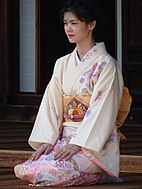

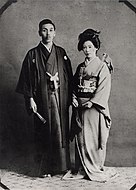
![Women's dress under Goguryeo influence, with overlapping collar and mo skirt.[5] (Takamatsuzuka Tomb, 7th century)](https://upload.wikimedia.org/wikipedia/commons/thumb/5/55/Takamat1.jpg/171px-Takamat1.jpg)

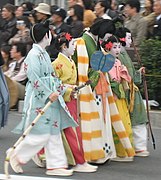
![In the late Heian period, the jūnihitoe consisted of many layers (hitoe) worn over a plain kosode and hakama.[16] (The Tale of Genji, 12th century)](https://upload.wikimedia.org/wikipedia/commons/thumb/9/96/Genji_emaki_TAKEKAWA.jpg/392px-Genji_emaki_TAKEKAWA.jpg)

